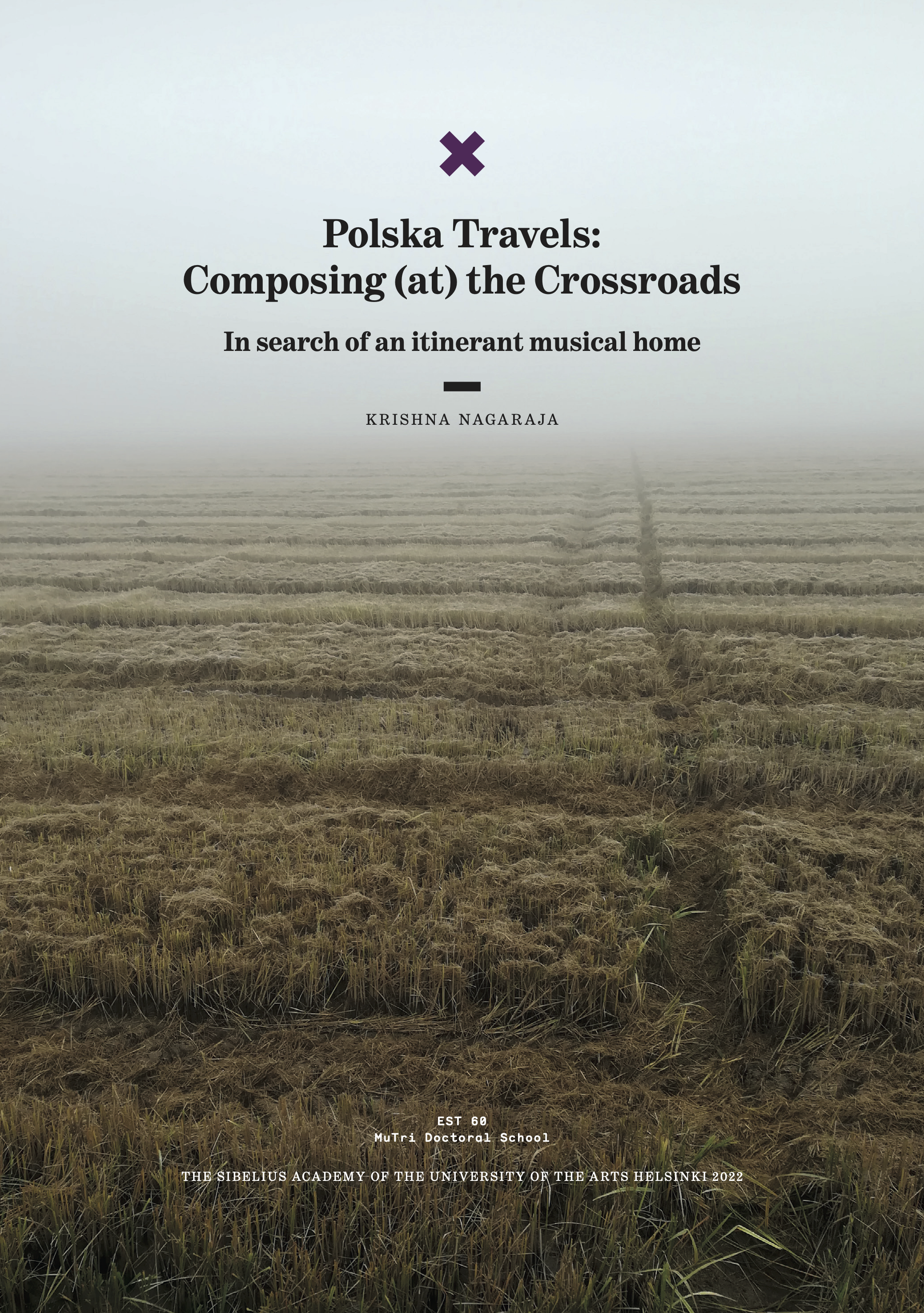Abstract
This thesis summarises and disseminates the findings of my artistic doctoral project Polska Travels, which applies the practice of composition and arrangement to the hybridisation of several musical genres, with folk music from Sweden, Finland, and Norway and Western art music as points of departure. The research studies the history of the polska tune family from its late renaissance and early baroque origins to the development of modern-day local variants, using the collected knowledge as the basis for original compositions and arrangements.
The geographical areas where the polska prospered and still thrives today provided the themes for a series of four concert programmes and one CD recording, presented for the fulfilment of the doctoral degree. My last doctoral composition, Stringar for string quartet (2020), is taken here as a case study to provide an example of how and where a specific folk repertoire – the music for the Norwegian Hardanger fiddle – can meet and permeate elements as foreign as progressive metal, Indian rhythms, and Western contemporary art music techniques. Each of the three movements in the quartet stems from a particular type of springar (a Norwegian relative of the polska), the boundaries of which it surpasses by stretching the inner characteristics of the tunes, reaching out to new territories.
Stringar constitutes the most relevant artistic answer to the research question of how to compose a “musical home” at the crossroads of different elements and influences. The interstitial space between disciplines and genres is the ground where composition is used as a research method to create a hybrid musical language that connects differences and transcends them. The research methodology is interdisciplinary: fields such as ethnomusicology, music theory, historically informed performance practice, and contemporary composition interact to generate common strands that are marshalled to gather the necessary knowledge for the foundation of the artistic outcomes. The outcomes themselves are transcultural, or hybrid, in that they aim to access a deeper level of dialogue between “Others”; various elements are synthesised into a personal, hybrid type of composition, which values the collected interdisciplinary knowledge as its foundation.
Based upon these premises, the findings of my research advance the idea of Stringar as a temporary musical home, and of the compositional process as an itinerant musical home. These artistic spaces are shaped through the agency of a personal tradition, wherein the individual composer and the surrounding bodies of knowledge are constantly negotiating their respective identities. By describing the construction of Stringar and explaining the reasons behind my artistic choices, I show how the composition answers the research question and contributes to the growing research that establishes connections between different musical fields and disciplines. With the present thesis I place the composition itself and the full doctoral project in the framework of academic artistic research, with the intention of expanding the concept of “contemporary music” into a broader, genre-free means of artistic expression.
Tiivistelmä
Tämä tutkielma kertoo taiteellisen tohtoritutkintoni Polska Travels tuloksista. Tohtoriprojektissani olen käyttänyt säveltämistä ja sovittamista erilaisten musiikinlajien ja musiikillisten tyylien hybridisoimiseen. Lähtökohtinani on ollut kansanmusiikkiperinteitä Ruotsista, Suomesta ja Norjasta sekä länsimaisen taidemusiikin perinne. Olen projektissa syventynyt polskan historiaan sen myöhäisen renessanssin ja varhaisen barokin aikaisista juurista aina tämän päivän paikallisiin toisintoihin saakka. Tutkimuksessa kertynyttä tieteellistä ja taiteellista tietoa olen käyttänyt uusien omien sävellysten ja sovitusteni lähtökohtana.
Ne maantieteelliset alueet, joilla polska kukoisti ja joilla se vielä nykyäänkin menestyy, tarjosivat teemat tohtoritutkintoni neljälle konserttiohjelmalle ja yhdelle CD-levylle. Viimeinen tohtoriprojektini sävellys Stringar jousikvartetille (2020) on tapaustutkimus, esimerkki siitä, kuinka ja missä kohtaa tietty kansanmusiikkisävelmistö – tässä tapauksessa norjalaisen hardangerviulun repertoaari – voi kohdata ja läpäistä sille niinkin vieraat elementit kuin progressiivinen metallimusiikki, intialaiset rytmit ja länsimaisen nykymusiikin tekniikat. Jokainen kvarteton kolmesta osasta nojaa tietyntyyppiseen springariin eli norjalaiseen versioon polskasta, mutta ylittää sen rajapintoja käsittelemällä ja laajentamalla kappaleiden luonteenomaisia ominaispiirteitä, kurottaen uusille alueille.
Stringar on tärkein taiteellinen vastaukseni siihen tutkimuskysymykseen, kuinka ”musiikillisen kodin” säveltäminen erilaisten materiaalien ja vaikutteiden risteyksessä on ollut mahdollista. Musiikillisten tyylien ja lajien välinen tila on maaperä, jossa säveltäminen on tutkimusmetodini. Sen avulla pyrin luomaan yhteen sulautuneen musiikillisen kielen, joka toisaalta yhdistää erilaiset elementit ja toisaalta läpäisee ne. Tutkimuksen metodologia on tieteiden- ja taiteidenvälinen: esimerkiksi etnomusikologian, musiikin teorian, historiatietoisen esittämisen (HIPP) ja säveltämisen kentät ovat vuorovaikutuksessa ja tuottavat tietopohjan taiteellisten komponenttien luomista varten. Taiteelliset tulokset itsessään ovat transkulttuurisia tai hybridisiä: ne pyrkivät pääsemään syvempään dialogiin ”Toisten” kanssa; moninaiset elementit sulautuvat persoonalliseksi, hybridiseksi säveltämisen tavaksi, joka arvostaa kerättyä monialaista tietoa, taitoa ja ymmärrystä lähtökohtanaan.
Näiden lähtökohtien pohjalta tutkimukseni määrittelee Stringarin väliaikaisena musiikillisena kotina ja säveltämisen prosessina, joka on mukana kulkeva musiikillinen koti. Nämä taiteelliset tilat muotoutuvat omakohtaisen perinteen kautta. Siinä säveltäjä ja häntä ympäröivät tietämysten kokonaisuudet muokkaavat jatkuvasti uudelleen omia identiteettejään. Samalla kun kerron Stringarin rakentumisesta ja taiteellisten valintojeni perusteluista, näytän miten säveltäminen vastaa tutkimuskysymykseen ja osallistuu siihen kasvavaan tutkimukselliseen keskusteluun, joka luo yhteyksiä erilaisten musiikillisten alojen ja perinteiden välille. Tämän tutkielman avulla sijoitan säveltämisen itsensä ja koko tohtoriprojektini taiteellisen tutkimuksen kentälle, tavoitteenani laajentaa ”nykymusiikin” käsitettä genrevapaan, laajemman taiteellisen ilmaisun suuntaan.
